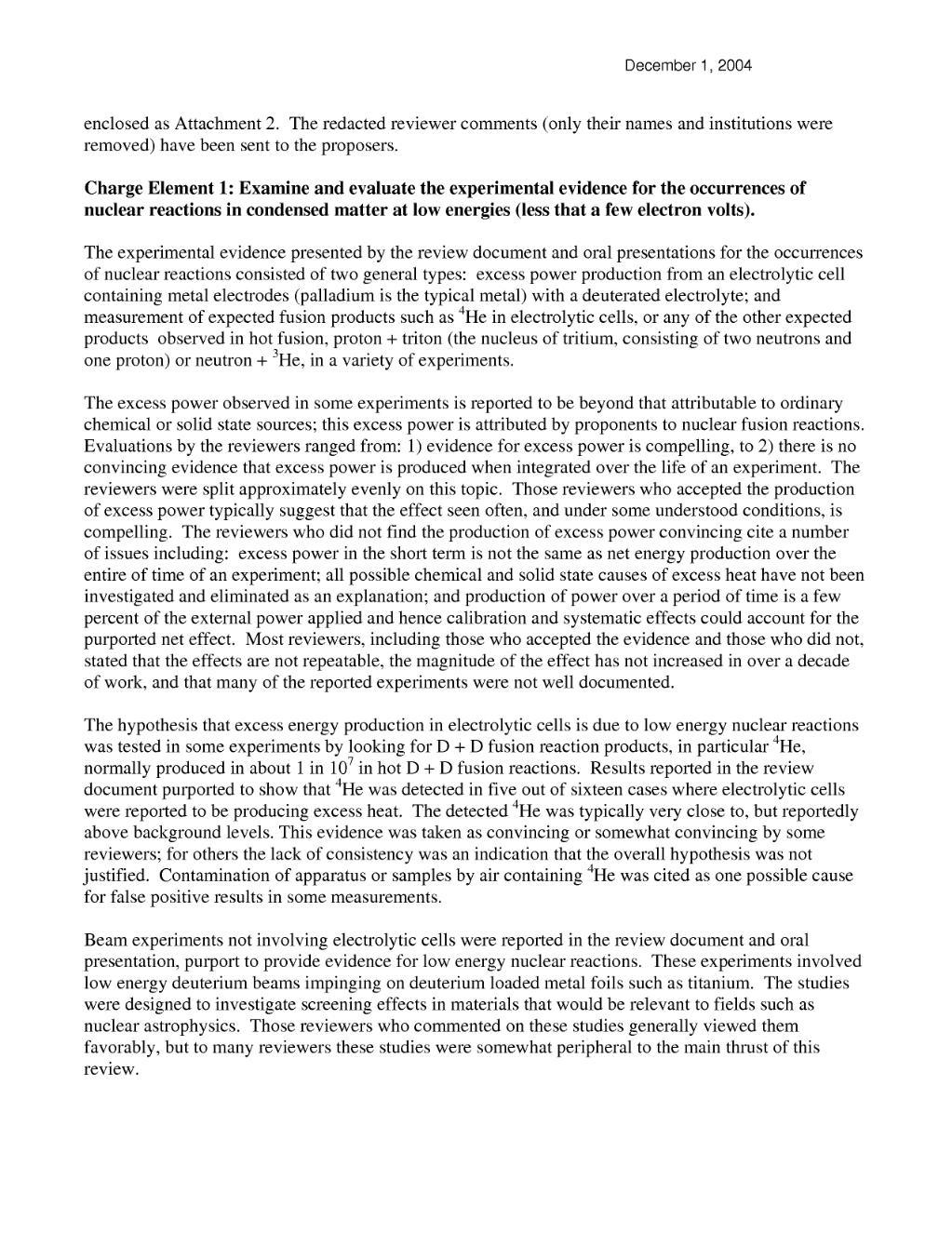enclosed as Attachment 2. The redacted reviewer comments (only their names and institutions were removed) have been sent to the proposers.
Charge Element 1: Examine and evaluate the experimental evidence for the occurrences of nuclear reactions in condensed matter at low energies (less that a few electron volts).
The experimental evidence presented by the review document and oral presentations for the occurrences of nuclear reactions consisted of two general types: excess power production from an electrolytic cell containing metal electrodes (palladium is the typical metal) with a deuterated electrolyte; and measurement of expected fusion products such as 4He in electrolytic cells, or any of the other expected products observed in hot fusion, proton + triton (the nucleus of tritium, consisting of two neutrons and one proton) or neutron + 3He, in a variety of experiments.
The excess power observed in some experiments is reported to be beyond that attributable to ordinary chemical or solid state sources; this excess power is attributed by proponents to nuclear fusion reactions. Evaluations by the reviewers ranged from: 1) evidence for excess power is compelling, to 2) there is no convincing evidence that excess power is produced when integrated over the life of an experiment. The reviewers were split approximately evenly on this topic. Those reviewers who accepted the production of excess power typically suggest that the effect seen often, and under some understood conditions, is compelling. The reviewers who did not find the production of excess power convincing cite a number of issues including: excess power in the short term is not the same as net energy production over the entire of time of an experiment; all possible chemical and solid state causes of excess heat have not been investigated and eliminated as an explanation; and production of power over a period of time is a few percent of the external power applied and hence calibration and systematic effects could account for the purported net effect. Most reviewers, including those who accepted the evidence and those who did not, stated that the effects are not repeatable, the magnitude of the effect has not increased in over a decade of work, and that many of the reported experiments were not well documented.
The hypothesis that excess energy production in electrolytic cells is due to low energy nuclear reactions was tested in some experiments by looking for D + D fusion reaction products, in particular 4He, normally produced in about 1 in 107 in hot D + D fusion reactions. Results reported in the review document purported to show that 4He was detected in five out of sixteen cases where electrolytic cells were reported to be producing excess heat. The detected 4He was typically very close to, but reportedly above background levels. This evidence was taken as convincing or somewhat convincing by some reviewers; for others the lack of consistency was an indication that the overall hypothesis was not justified. Contamination of apparatus or samples by air containing 4 He was cited as one possible cause for false positive results in some measurements.
Beam experiments not involving electrolytic cells were reported in the review document and oral presentation, purport to provide evidence for low energy nuclear reactions. These experiments involved low energy deuterium beams impinging on deuterium loaded metal foils such as titanium. The studies were designed to investigate screening effects in materials that would be relevant to fields such as nuclear astrophysics. Those reviewers who commented on these studies generally viewed them favorably, but to many reviewers these studies were somewhat peripheral to the main thrust of this review.
